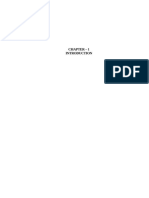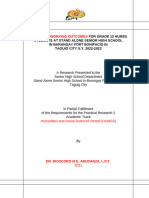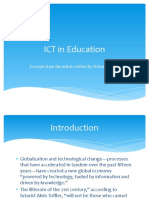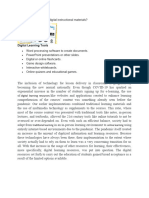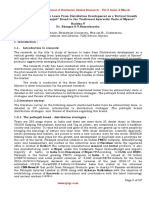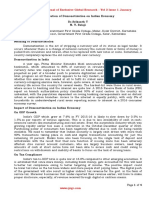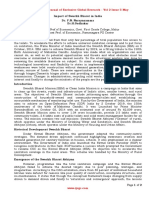Role of ICT in Higher Education and Its Challenges For The 21st Century
Role of ICT in Higher Education and Its Challenges For The 21st Century
Uploaded by
archerselevatorsCopyright:
Available Formats
Role of ICT in Higher Education and Its Challenges For The 21st Century
Role of ICT in Higher Education and Its Challenges For The 21st Century
Uploaded by
archerselevatorsOriginal Description:
Original Title
Copyright
Available Formats
Share this document
Did you find this document useful?
Is this content inappropriate?
Copyright:
Available Formats
Role of ICT in Higher Education and Its Challenges For The 21st Century
Role of ICT in Higher Education and Its Challenges For The 21st Century
Uploaded by
archerselevatorsCopyright:
Available Formats
AEIJMR Vol 4 Issue 6 June 2016 ISSN - 2348 - 6724
Role of ICT in Higher Education and Its Challenges for the 21st Century
*Vandana Sharma & Simmi
*Assistant Professor, DAV College, Sector 10, Chandigarh
Abstract
Education means development of overall personality which includes physical,
cognitive, affective and spiritual well-being of learner. ICT (Information and
Communication Technology) is a gift of 21st century to human-kind. In recent
years, ICT has rapidly acquired a special place in society. Without doubt, this is
also true in education. However, one of the most common problems of using ICT in
education is to base choices on technological possibilities rather than educational
needs. This paper attempts to highlight the role of ICT in higher education and its
challenges for the 21st century.
Keywords: Higher Education, Information and Communication Technology (ICT)
Introduction
Education plays an important role in the development of any nation. Education
tells people how to think, how to act, and how to make decisions. The better your
education, the more choices and opportunities you are going to have in life. In
India, education system was as old as the Indian civilization, but the modern
education system faces many challenges. When we talks about education, we do
not limit us with formal education, it also includes informal and non-formal
education.
In India, higher education is viewed as a powerful means to build knowledge based
society. The Indian Higher Education System has established itself as the largest
system in the world in terms of number of institutions and third largest in terms of
student enrollment (after China and USA). While several new institutions have
emerged due to significant increase in private sector participation over the last few
years, concerns remain regarding the quality of education being imparted to
students.
What is ICT?
Information and Communication Technologies (ICTs) are referred to as the varied
collection of technological gear and resources which are made use of to
communicate. They are also made use of to generate, distribute, collect and
administer information. Information and Communication Technologies consist of
the hardware, software, networks, and media for collection, storage, processing,
transmission and presentation of information (voice, data, text, images), as well as
related services. ICT is a force that has changed many aspects of the way we live.
When looking at the integration of ICT to support the achievement of educational
objectives, it can be found that after almost two decade of using ICT to stimulate
development, it is not yet fully integrated in development activities and awareness
rising is still required. ICT is about the new ways in which people can
communicate, inquire, make decisions and solve problems. It is the processes, tools
and techniques for:
gathering and identifying information
classifying and organizing
summarizing and synthesizing
analyzing and evaluating
speculating and predicting
1
www.aeph.in
AEIJMR Vol 4 Issue 6 June 2016 ISSN - 2348 - 6724
ICT and Higher Education
The major teaching and learning challenges facing higher education revolve around
student diversity, which includes, amongst others, diversity in students academic
preparedness, language, caste, gender, class and schooling background.
Integrating ICT in teaching-learning process is high on the educational reform
agenda. ICTs need to be seen as an essential aspect of teaching toolkit in the 21st
century, affording new and transformative models of development that extend the
nature and reach of teaching-learning process wherever it takes place.
ICTs are also tools which enable and bring about transformation which, when used
properly, can encourage the shift an environment which is learner-centered. ICTs
which can be in the form of videos, television and also computer multi-media
software, that merges sound, transcripts and multicolored moving imagery, can be
made use of so as to make available stimulating, thought provoking and reliable
content that will keep the student interested in the learning process.
ICT in Research
Application of ICT in higher education research is very powerful. Research area in
higher education benefited the most from the use of ICT. The application of ICTs in
academic research has grown steadily in the past 10 to 15 years in both developing
as well as developed countries, although there are wide variations in usage both
within and between countries and regions.
In India, four areas are particularly important for ICT in research:
Firstly, it provides the infrastructure (computers, broadband, wireless, etc), data
collection and storage, processing, computing power, visualization, simulations.
Secondly, the combination of communications and digital libraries is equalizing
access to academic resources, greatly enriching research possibilities for smaller
institutions and those outside the big cities. Digital libraries are very useful for the
institutions specially situated in the tribal and rural area. These digital libraries
provide researchers with online access to the contents of hundreds of thousands of
books from major publishing houses, research reports, and peer- reviewed articles
in electric journals.
Thirdly, the steady increases in bandwidth and computing power available have
made it possible to conduct complex calculations on large data sets.
Lastly, communication links make it possible for research teams to be spread
across the world instead of concentrated in a single institution.
ICT in Teaching
ICTs are a powerful tool for extending educational opportunities, both formal and
non-formal, to scattered (tribal) and rural populations, groups traditionally
excluded from education due to cultural or social reasons such as ethnic
minorities, girls and women, persons with disabilities, and the elderly, as well as all
others who for reasons of cost or because of time constraints are unable to enroll
on campus.
ICTs make teaching-learning process possible and within a reach, by a time lag
between the delivery of instruction and its reception by learners. Online course
materials, for example, may be accessed 24 hours a day, 7 days a week. Teachers
and learners no longer have to rely solely on printed books and other materials in
physical media housed in libraries (and available in limited quantities) for their
educational needs. With the Internet, a wealth of learning materials in almost every
subject and in a variety of media can now be accessed from anywhere at any time
of the day and by an unlimited number of people.
2
www.aeph.in
AEIJMR Vol 4 Issue 6 June 2016 ISSN - 2348 - 6724
United Nations Educational, Scientific and Cultural Organization (UNESCO)
principles on ICT in education can be summarized as follows:
Old and new technologies need to be used in a balanced way. On-the-air and offthe-air radio/radio-cassette, television and offline video-assisted technologies are
still considered valid and cost-effective modes of education delivery, as important
as more interactive computer/Internet-based virtual education or online distance
learning.
The demand for higher education cannot be met in both the developed and
developing world without distance or virtual modes of learning.
Vocational training needs cannot be met without virtual classes, virtual
laboratories, etc.
Educational goals cannot be met without gender sensitivity. Wherever possible,
the proposed indicators will address the need to measure the gender gap.
Large Classroom
The growth of mass higher education has made large classes an endemic feature of
several courses at higher education institutions. Large class sizes make it difficult
for teachers to employ interactive teaching strategies or to gain insight into the
difficulties experienced by students. Large classes pose problems for all students
but students who are under-prepared are particularly affected. It is these contexts
that provide useful opportunities for educational technologies.
Use of ICTS for Inclusive Education
Inclusive Education proposes all students are provided with equal access to
education within the context of a mainstream educational system and not in a
segregated setting. Accessible ICTs have a major role to play in enabling
educational authorities, educators, students and parents to move towards a more
inclusive educational system.
Specific benefits for students:
Computers can improve independent access for students to education
Students with special educational needs are able to accomplish tasks working at
their own pace
Visually impaired students using the internet can access information alongside
their sighted peers
Students with profound and multiple learning difficulties can communicate more
easily
Students using voice communication aids gain confidence and social credibility
at college/university and in their communities as well
Increased ICT confidence amongst students motivates them to use the internet
at home for assignment and leisure interests.
Benefits for teachers:
Supports reflection on professional practice via online communication
Enhances professional development and the effectiveness of the use of ICT with
students through collaboration with peers
Materials already in electronic form (for example, from the internet) are more
easily adapted into accessible resources such as large print or Braille.
Benefits for parent:
3
www.aeph.in
AEIJMR Vol 4 Issue 6 June 2016 ISSN - 2348 - 6724
Use of voice communication aids encourages parents to have higher
expectations of childrens sociability.
Challenges Faced By ICT in India
While using ICTs in teaching has some obvious benefits, ICTs also bring challenges.
Firstly, the high cost of acquiring, installing, operating, maintaining and
replacing ICTs.
Secondly, introducing ICT systems for teaching in India has a particularly high
opportunity cost because installing them is usually more expensive in absolute
terms than in industrialized countries whereas, in contrast, alternative investments
(e.g., buildings) are relatively less costly here.
Thirdly, using unlicensed software can be very problematic, not only legally but
in the costs of maintenance, particularly if the pirated software varies in standard
formats.
Fourthly, even though students can benefit immensely from well-produced
learning resources, online teaching has its own unique challenges as not all
faculties are ICT literate and can teach using ICT tools.
Fifthly, the basic requirement of electricity and telephone networks is not
available in some part of the country. Also many collages do not have proper rooms
or buildings so as to accommodate the technology.
Lastly, the four most common mistakes in introducing ICTs into teaching are:
i) installing learning technology without reviewing student needs and content
availability;
ii) imposing technological systems from the top down without involving faculty and
students;
iii) using inappropriate content from other regions of the world without customizing
it appropriately; and
iv) Producing low quality content that has poor instructional design and is not
adapted to the technology in use.
In India, another challenge is that the teachers need to develop their own capacity
so as to efficiently make use of the different ICTs in different situations. They
should not be scared that ICTs would replace them as English being the dominant
language most of the online content is in English. This causes problems as in India
the people are not comfortable with English.
Conclusions
As move into the 21st century, many factors are bringing strong forces to bear on
the adoption of ICTs in higher education. It is believed that the use of ICT in
education can increase access to learning opportunities. It can help to enhance the
quality of education with advanced teaching methods, improve learning outcomes
and enable reform or better education systems. The integration of ICTs in higher
education is inevitable. One of the great benefits of ICTs in teaching is that they
can improve the quality and the quantity of educational provision. For this to
happen however, they must be used appropriately. The use of ICT creates an open
environment which enables the storage and the reuse of information materials as
also it enables the interface among the teachers as well as students.
Bibliography
Bonn S. (2008). Transitioning from Traditional to Hybrid and Online Teaching,
Anil Varma (Ed), Information and Communication Technology in Education, First
edition, ICFAI University Press, Hyderabad, p.34-35.
4
www.aeph.in
AEIJMR Vol 4 Issue 6 June 2016 ISSN - 2348 - 6724
Core ICT indicators: Partnership on measuring ICT for development, retrieved
May14,2016 from http://www.itu.int/ITU-D/ict/partnership/
Developing research-based learning using ICT in higher education curricula: The
role
of
research
and
evaluation,
retrieved
May
14,2016
from
http://knowledge.cta.int/en/content/view/full/12690
Guide to measuring Information and Communication Technologies (ICT) in
education,
UNESCO,
retrieved
May
15,2016
from
http://www.uis.unesco.org/ev_en.php?ID=7856_201&ID2=DO_TOPIC and
http://www.unctad.org/en/docs//iteipc20031_en.pdf
Information and Communication Technology, retrieved May 16, 2016 from
Wende M. V. D. 2002. The Role of US higher education in the global e-learning
market,
retrieved
May
16,
2016
from
http://cshe.berkeley.edu/publications/docs/ROP.WendePaper1.02.pdf
5
www.aeph.in
You might also like
- The Role of ICT in Higher Education For The 21st Century: ICT As A Change Agent For EducationDocument8 pagesThe Role of ICT in Higher Education For The 21st Century: ICT As A Change Agent For EducationAroop MukherjeeNo ratings yet
- Input Tax Credit Under GST in India An OverviewDocument8 pagesInput Tax Credit Under GST in India An OverviewarcherselevatorsNo ratings yet
- XP11 FF 767-300ER Guide PDFDocument180 pagesXP11 FF 767-300ER Guide PDFMax Hayes100% (1)
- Chapter 1Document45 pagesChapter 1ypunia.pgtNo ratings yet
- 1 6 16 483Document5 pages1 6 16 483Multidisciplinary JournalNo ratings yet
- Introduction and Conceptual FrameworkDocument25 pagesIntroduction and Conceptual FrameworkAeron ArestaNo ratings yet
- DberDocument6 pagesDberJohn KakomaNo ratings yet
- Ict and Distance LearningDocument4 pagesIct and Distance LearningSalma JanNo ratings yet
- Role of ICT in EducationDocument4 pagesRole of ICT in EducationAbdulRehman100% (1)
- Applications of ICT in EducationDocument8 pagesApplications of ICT in EducationZ I A DNo ratings yet
- Mid-Term Examination Educ 63 (Technology For Teaching and Learning)Document4 pagesMid-Term Examination Educ 63 (Technology For Teaching and Learning)Zaan MarkNo ratings yet
- The Science Probe VolDocument19 pagesThe Science Probe VolRozi FakhroziNo ratings yet
- Ict Social Science Disotation^Document13 pagesIct Social Science Disotation^Sanjay sunaNo ratings yet
- St. John College of Engineering and Management (Formerly St. John College of Engineering and Technology)Document32 pagesSt. John College of Engineering and Management (Formerly St. John College of Engineering and Technology)Dr. Eknath PatilNo ratings yet
- Role of ICT in Higher EducationDocument5 pagesRole of ICT in Higher EducationregalNo ratings yet
- Information and Communication Technologies in EducationDocument6 pagesInformation and Communication Technologies in EducationYolanda Fresiska JayaNo ratings yet
- Relevance of ICT in Education and Role of TeacherDocument11 pagesRelevance of ICT in Education and Role of TeacherRithu SanthoshNo ratings yet
- Reasearch - Paper - 2 With Cover Page v2Document12 pagesReasearch - Paper - 2 With Cover Page v2Nagô O ReiNo ratings yet
- Main Project Chapter 1Document39 pagesMain Project Chapter 1Point Take plus ltdNo ratings yet
- CHAPTER-1Document15 pagesCHAPTER-1Chand Kris MejicaNo ratings yet
- E-Education in India With Special Reference To Andhra PradeshDocument6 pagesE-Education in India With Special Reference To Andhra PradeshRakeshconclaveNo ratings yet
- The Promise of ICTs in EducationDocument19 pagesThe Promise of ICTs in EducationRanjit SlathiaNo ratings yet
- What Is ICTDocument10 pagesWhat Is ICTnaveedbro666No ratings yet
- PHD Thesis Ict in EducationDocument4 pagesPHD Thesis Ict in Educationlynnwebersaintpaul100% (2)
- Kiki Agustinar CallDocument3 pagesKiki Agustinar CallSundusil ArsyiNo ratings yet
- bosun chapter 1Document9 pagesbosun chapter 1tgt4sjv9jxNo ratings yet
- ProjectDocument32 pagesProjectSt CharlesNo ratings yet
- Need and Importance of Information Technology in EducationDocument5 pagesNeed and Importance of Information Technology in EducationvinodshendgeNo ratings yet
- Rapanan, Mikaela S.Document9 pagesRapanan, Mikaela S.Mika RapananNo ratings yet
- The Role of Information and Communicatio PDFDocument11 pagesThe Role of Information and Communicatio PDFsupri yantiNo ratings yet
- Senior High School Students Awareness An 3f67abb8Document13 pagesSenior High School Students Awareness An 3f67abb8restolesrhianroseNo ratings yet
- Will Icts Replace The Teacher?Document4 pagesWill Icts Replace The Teacher?nazlaNo ratings yet
- The Role of Information and CommunicatioDocument13 pagesThe Role of Information and CommunicatioMohamed Osman MohamudNo ratings yet
- ICT Laboratory Work 14Document8 pagesICT Laboratory Work 14Bota055No ratings yet
- ICT in EducationDocument26 pagesICT in EducationKing ZateNo ratings yet
- Introduction To Ict OngoingDocument27 pagesIntroduction To Ict Ongoinggracioussunday09No ratings yet
- Assessing The Use of ICT in Teaching Amd LearningDocument18 pagesAssessing The Use of ICT in Teaching Amd LearningKagyera KatakaraNo ratings yet
- DR TunjiDocument4 pagesDR Tunjifaith essienNo ratings yet
- Technology and Teacher EducationDocument18 pagesTechnology and Teacher Educationaldaneji100% (1)
- The Role and Importance of Information and Communication Technology in The Management of Professional Educational Institutions in IndiaDocument8 pagesThe Role and Importance of Information and Communication Technology in The Management of Professional Educational Institutions in Indiabmerf indiaNo ratings yet
- ICT AdvantagesDocument4 pagesICT AdvantagesRonaldo YabutNo ratings yet
- Role of Information & Communication Technology in EducationDocument7 pagesRole of Information & Communication Technology in EducationAnonymous CwJeBCAXpNo ratings yet
- Chapter One: Introduction To The StudyDocument11 pagesChapter One: Introduction To The StudySanjaya PoudelNo ratings yet
- Impact of Information Technology On Higher Education in Pakistan (A Study On People of Faisalabad, Pakistan)Document10 pagesImpact of Information Technology On Higher Education in Pakistan (A Study On People of Faisalabad, Pakistan)inventionjournalsNo ratings yet
- MawaDocument9 pagesMawaAmin AbdalNo ratings yet
- (Chapter One) A Study of The Computer Laboratory in Edo State Secondary School and The Problem Faced by Teacher in The Use of The LaboratoryDocument17 pages(Chapter One) A Study of The Computer Laboratory in Edo State Secondary School and The Problem Faced by Teacher in The Use of The LaboratoryDaniella BriggsNo ratings yet
- The Use of Information and Commmunication Technology in Distance EducationDocument7 pagesThe Use of Information and Commmunication Technology in Distance EducationManas BeckNo ratings yet
- Literacy and ICTDocument5 pagesLiteracy and ICTGusti Ntug IndRaNo ratings yet
- EJ1335793Document11 pagesEJ1335793josephine tagupaNo ratings yet
- Internet. WithpgDocument18 pagesInternet. WithpgKylene MagtibayNo ratings yet
- Ict in Education A Critical Literature Review and Its ImplicationsDocument5 pagesIct in Education A Critical Literature Review and Its ImplicationseatlotbndNo ratings yet
- ICT Overview: Class 01Document47 pagesICT Overview: Class 01banerjee97481No ratings yet
- Paradigm Shift in Open Education and E-Learning Resources As Teaching and Learning in Mellissa AcostaDocument12 pagesParadigm Shift in Open Education and E-Learning Resources As Teaching and Learning in Mellissa AcostaGlenda AstodilloNo ratings yet
- DocumentDocument13 pagesDocumentrahul.cyberdnn181No ratings yet
- Teachers' Perception On Acceptance and Benefits of Integrating ICT in Teaching in Senior Secondary Schools in Mangu LGA, Plateau State, Nigeria-2Document11 pagesTeachers' Perception On Acceptance and Benefits of Integrating ICT in Teaching in Senior Secondary Schools in Mangu LGA, Plateau State, Nigeria-2vdomshakNo ratings yet
- Digital Instructional MaterialsDocument7 pagesDigital Instructional MaterialsPsyche Gabrielle Bol-anonNo ratings yet
- Information and Communication Technology in Education and Psychological Bases of Imploying Ict in EducationDocument9 pagesInformation and Communication Technology in Education and Psychological Bases of Imploying Ict in EducationAmiya ArnavNo ratings yet
- What Is ICT All About in The Field of Education?Document3 pagesWhat Is ICT All About in The Field of Education?PIRATE -HNo ratings yet
- Ijrar Issue 20543139Document8 pagesIjrar Issue 20543139Swathi haveriNo ratings yet
- Technology Is Everywhere in Almost Every Part of Our LivesDocument3 pagesTechnology Is Everywhere in Almost Every Part of Our LivesVictorNo ratings yet
- Oil of Lavandula Angustifolia On Amyloid Beta PolymerizationDocument7 pagesOil of Lavandula Angustifolia On Amyloid Beta PolymerizationarcherselevatorsNo ratings yet
- Comparative Evaluation of Ethyl Acetate, Hexane and MethanolDocument6 pagesComparative Evaluation of Ethyl Acetate, Hexane and MethanolarcherselevatorsNo ratings yet
- Impact of GST On Small and Medium EnterprisesDocument5 pagesImpact of GST On Small and Medium Enterprisesarcherselevators0% (2)
- International Journal of Exclusive Global Research - Vol 3 Issue 3 MarchDocument17 pagesInternational Journal of Exclusive Global Research - Vol 3 Issue 3 MarcharcherselevatorsNo ratings yet
- Different Approaches in Pharmacological ResearchDocument3 pagesDifferent Approaches in Pharmacological ResearcharcherselevatorsNo ratings yet
- Role of NSS in Cleanliness With Special Reference To Dakshina KannadaDocument4 pagesRole of NSS in Cleanliness With Special Reference To Dakshina KannadaarcherselevatorsNo ratings yet
- Financial Inclusion A Gateway To Reduce Corruption Through Direct Benefit Transfer (DBT)Document7 pagesFinancial Inclusion A Gateway To Reduce Corruption Through Direct Benefit Transfer (DBT)archerselevatorsNo ratings yet
- Implication of Demonetization On Indian EconomyDocument4 pagesImplication of Demonetization On Indian EconomyarcherselevatorsNo ratings yet
- A Study On Swachh Bharat Abhiyan and Management LessonsDocument2 pagesA Study On Swachh Bharat Abhiyan and Management LessonsarcherselevatorsNo ratings yet
- Post Impact of Demonetization On Retail Sector A Case Study On Retail Outlets at Malur Town of Kolar DistrictDocument3 pagesPost Impact of Demonetization On Retail Sector A Case Study On Retail Outlets at Malur Town of Kolar DistrictarcherselevatorsNo ratings yet
- Demonetization 2016 Impact On Indian EconomyDocument9 pagesDemonetization 2016 Impact On Indian EconomyarcherselevatorsNo ratings yet
- Demonetization-A Boon or BaneDocument6 pagesDemonetization-A Boon or BanearcherselevatorsNo ratings yet
- Managing Municipal Solid Waste Some SuggestionsDocument2 pagesManaging Municipal Solid Waste Some SuggestionsarcherselevatorsNo ratings yet
- Role of National Service Scheme and Educational Institutions in Sanitation and Cleaning Within in Kolar DistrictDocument2 pagesRole of National Service Scheme and Educational Institutions in Sanitation and Cleaning Within in Kolar Districtarcherselevators100% (1)
- Eradication of Manual Scavenging Policy and PerspectiveDocument1 pageEradication of Manual Scavenging Policy and PerspectivearcherselevatorsNo ratings yet
- Role of National Service Scheme in Rural DevelopmentDocument5 pagesRole of National Service Scheme in Rural Developmentarcherselevators50% (2)
- Swachhatha Related To Children and Their EnvironmentDocument3 pagesSwachhatha Related To Children and Their EnvironmentarcherselevatorsNo ratings yet
- Sanitation and Its Impact On HealthDocument4 pagesSanitation and Its Impact On HealtharcherselevatorsNo ratings yet
- Swachh Bharat Abhiyan and The MediaDocument4 pagesSwachh Bharat Abhiyan and The MediaarcherselevatorsNo ratings yet
- Watershed Approach For Rainwater ManagementDocument8 pagesWatershed Approach For Rainwater ManagementarcherselevatorsNo ratings yet
- Living Conditions in Slums A Case Study in Bangalore CityDocument3 pagesLiving Conditions in Slums A Case Study in Bangalore CityarcherselevatorsNo ratings yet
- Sanitation and HealthDocument5 pagesSanitation and HealtharcherselevatorsNo ratings yet
- Impact of Swachh Bharat in IndiaDocument2 pagesImpact of Swachh Bharat in IndiaarcherselevatorsNo ratings yet
- Data Sheet: Fiber Optical Repeater Remote UnitDocument2 pagesData Sheet: Fiber Optical Repeater Remote UnitRami Abu AlhigaNo ratings yet
- Irfb 7537Document13 pagesIrfb 7537Cris ducusinNo ratings yet
- West Easton Sends Threat To File Charges For Pig OwnershipDocument2 pagesWest Easton Sends Threat To File Charges For Pig OwnershipTricia PhillipsNo ratings yet
- SEM210 Unit3Document22 pagesSEM210 Unit3satishbhaskarNo ratings yet
- Circuit ElementsDocument5 pagesCircuit ElementsJim TomoricNo ratings yet
- InteliDrive Marine DatasheetDocument4 pagesInteliDrive Marine Datasheethapem4No ratings yet
- Sreevidya Nair - PresentationDocument16 pagesSreevidya Nair - PresentationArk GroupNo ratings yet
- Ika Catalog 2011Document86 pagesIka Catalog 2011David SantiagoNo ratings yet
- Ayat-Ayat Cinta - 3Document5 pagesAyat-Ayat Cinta - 3Ag AHsNo ratings yet
- Spectrum Analyzer Aaronia Spectran HF-6000-Series PDFDocument10 pagesSpectrum Analyzer Aaronia Spectran HF-6000-Series PDFDavid KřížNo ratings yet
- Mobile Cloud Computing PresentationDocument14 pagesMobile Cloud Computing PresentationJannatun NesaNo ratings yet
- MVP 6100 - Series 20231031Document2 pagesMVP 6100 - Series 20231031hirokimitoNo ratings yet
- Naga Siri Chandana ChowdaryDocument9 pagesNaga Siri Chandana ChowdaryxovoNo ratings yet
- DockerDocument37 pagesDockervitalcloudiacNo ratings yet
- IEC 60601 1 4th Ed FINAL Design Specification Outline 1701413653Document32 pagesIEC 60601 1 4th Ed FINAL Design Specification Outline 1701413653FVNo ratings yet
- Tl-Pa7020 (Kit) V2V3 UgDocument16 pagesTl-Pa7020 (Kit) V2V3 UgAldemi P. JuniorNo ratings yet
- ISM - CP - 7-7-2022 MPSTME Course OutlineDocument10 pagesISM - CP - 7-7-2022 MPSTME Course OutlineEshan JainNo ratings yet
- LS 6 Digital Literacy Activity Sheet 1 4Document7 pagesLS 6 Digital Literacy Activity Sheet 1 4frdrck.dl2127No ratings yet
- Security Policy Case StudyDocument23 pagesSecurity Policy Case StudyAshu VaykoleNo ratings yet
- 2012 Technical Catalogue VRFDocument68 pages2012 Technical Catalogue VRFbirlograresNo ratings yet
- CS - Lesson 1 Activity WorkDocument4 pagesCS - Lesson 1 Activity WorkjjjNo ratings yet
- IP Surveillance API User Guide: Revision 4 2013-12Document3 pagesIP Surveillance API User Guide: Revision 4 2013-12dapuzzNo ratings yet
- 3-Establishment of DSSC ICTC HubDocument4 pages3-Establishment of DSSC ICTC HubCharlesNo ratings yet
- Cut-Over Activities For SAP PMDocument4 pagesCut-Over Activities For SAP PMsagar_kanadeNo ratings yet
- Service ManualDocument86 pagesService ManualBarbara RoldanNo ratings yet
- PT&TK 2022 BaiTap2Document8 pagesPT&TK 2022 BaiTap2Mai LyNo ratings yet
- Assignment-12 RulesDocument2 pagesAssignment-12 RulesvajavakshhapauslsbNo ratings yet
- License AgreementDocument2 pagesLicense AgreementBob DelareuelleNo ratings yet
- Namur 43Document28 pagesNamur 43Subrangshu100% (1)












